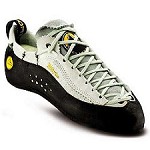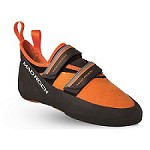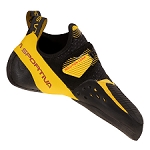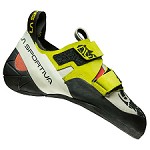If you have decided to take up climbing, whether you start in a gym or on rock, an essential piece of equipment is a pair of climbing shoes. In this article, we will give you tips on how to select the right shoe from the wide range of climbing shoes available.

Choosing the right climbing shoes to get started climbing. Photo Greg Mionske / SCARPA
Have you been itching to start climbing? Inspired by your friends, photos or videos? Maybe you've watched it at the Olympics and even tried it out at a climbing wall.
Whatever the reason, if you are unsure where to start, the first thing you’ll need is the right footwear.
It’s important to take time and get advice before rushing into buying your first pair of climbing shoes. It’s no easy task finding a good fit that offers as much comfort as possible.
Can any Climbing Shoe be Used to Climb any Route?
No, climbing shoes are designed for a specific purpose; for slabs, overhangs, cracks, bouldering, speed climbing, rental, and so on. Logically they come in different sizes and they are also made for women, men and children. You can read about this in our article
“How to Choose Your Rock Climbing Shoes.”
In order to select the most suitable beginner’s climbing shoe, you need to have certain criteria so that you can filter through the huge range of shoes available.
Traditionally, initiation climbing was defined by the entire learning process that leads to being able to climb an equipped route by yourself, which includes learning the various manoeuvrers, belaying techniques and progression in all its variants.
However, the new trend of indoor climbing and bouldering, using assisted belay devices, changes this definition. Nowadays, you find climbers with a high level, with no interest in climbing on rock or with no knowledge of basic rock climbing techniques.

It’s becoming more common to climb at an indoor wall than outside on the rock. Photo Tristan Hobson
Others may be veteran climbers who feel more comfortable on the same grade and on low-difficulty routes. This makes us rethink the definition of an initiation route.
Initiation Routes
So initiation climbing could be redefined as low grade or non-difficult routes. By this, we mean climbing routes that are not excessively vertical and have generous holds, where a lack of strength and specific climbing technique is not a limiting factor.
Both the quality of the holds and verticality of the route are related. A fairly vertical route can be for beginners if the holds are excellent. On the contrary, a route with smaller holds can be considered easy if it has a more sloping angle. It is clear therefore that the easier the route, the less effort is required.

First day of climbing: top rope on easy-angled slopes
The reason we are explaining all this is that the features of a beginner’s climbing shoe make it more or less suitable depending on the type of routes you plan to climb.
Beginners
Beginners usually progress from level zero to medium at a smooth pace and that is how it should be. Strength, technique and mental skills are very important, but it is also important to learn and use the different knots and manoeuvrers that are essential for getting out of different situations.
However attractive a route may seem, it is important to progress at a moderate pace and not try to rush and climb overhangs or long multi-pitch routes at the beginning.
Initiation climbing routes usually have large holds that provide good support for your feet. The smaller holds should be avoided because they often require an asymmetrical climbing shoe with a curved profile that concentrates the power on the big toe. In contrast, newcomers need a fairly symmetrical show with a flat profile, for enhanced comfort. We will explain why.
Depending on the shape and design of a climbing shoe, it is more or less comfortable. A beginner’s shoe has the most comfortable design, but as you progress and move onto more difficult and technical routes, you may want to change to the next level of climbing shoe. However, the more adapted a shoe is to technical routes, the less comfortable it is.

Climbing shoes specifically designed for children.
Most beginners find that they need to develop certain muscles and strength for climbing. Given the particular nature of such a vertical environment, fear or caution will often cause climbers to use more force than is really necessary. This is normal, and it even happens to experienced climbers who "squeeze" the holds more than necessary in high-risk moves. Beginners will often experience this from the start to finish of a route.
This is where the climbing shoe stands out, as it is able to compensate for the involuntarily use of more force than necessary and lack of muscular strength. The beginner’s climbing shoe has been designed to provide rigid support for enhanced stability to the whole foot and this means that the climber only requires a minimum amount of force to prevent the sole from bending. This is clearly an advantage as it economises strength, but it also means that it is less sensitive and prevents the climber from feeling smaller holds, if you progress to a more difficult route.
What do I Look for in my First Climbing Shoe?
It is generally recommended that socks should not be worn with climbing shoes, unless using special socks for winter climbing. This is because socks tend to wrinkle and this can be painful and reduce sensitivity. Bear this in mind when choosing your size and last.
When choosing a pair of climbing shoes for initiation routes, the following points should be taken into account:
Size and Shape
Unless you have extraordinary skills, most beginners will take time first searching for the right holds and then building up confidence to move a hand or foot from one hold to another. All this requires much concentration and you don’t want any distractions such as sore feet to get in your way.
Size
As with any activity, it is essential to choose the right size of climbing shoe. As you gain experience, you will learn that a tighter shoe inhibits toe flex but less force is required on the holds. Tight shoes are very precise but they are also painful and are only required for technical routes, overhangs, etc.
A shoe with a larger toe box does not give a great deal of precision on small holds, since the toe box tends to flex.
A beginner’s climbing shoe should, therefore provide a snug, but not tight fit. If you are in doubt between two sizes, it’s usually best to choose the slightly tighter fit. As a general rule, beginners should choose the same size used for normal footwear, or half a size less if you think the shoe will yield with use. Check out this article for information on upper materials .

Adidas Five.Ten Kirigami W. Be careful when using brand size charts.
Be particularly careful with the sizing of Adidas Five.Ten climbing shoes, especially if you have already used footwear by this brand. This is because the new models tend to have a much tighter fit and climbers often find they need half a size larger.
Last
Climbing shoes usually have an asymmetrical shape, which tends to curve inwards. This makes it perform better on small holds but it is much less comfortable.
As a beginner, look for a straight last that is snug enough to keep your toes together with no space between them, but does not feel uncomfortably tight. The difference can be subtle, but it is important to choose a shoe that is neither too loose or too tight.

Tenaya Ra Low Volume. Climbing shoe with a comfortable last and reduced volume.
Profile
Viewed from the side, a climbing shoe, usually has a slight arch between the heel and the forefoot. This allows you to concentrate the entire force of the foot on the toe, but this is only required for medium to high difficulty routes with minimal holds or for overhangs.
An arched profile is not necessary for easy routes and it will only cause discomfort. For this reason, beginners should opt for a flat profile. This will ensure comfortable support on sloping routes and generous holds.

The SCARPA Reflex with a flat profile is perfect for beginners.
A tip for checking if a beginners shoe is the right size for you is that it should allow you to stand comfortably, but not walk naturally.
The Quality of Climbing Shoe Materials
Now we’ve talked about the sizing and shape required in order to progress on easy routes, let's look at the materials used, how they vary and why they are important.
Price
We do not usually start by mentioning the price differences, but in this case it is important to discuss the wide range of entry-level climbing shoes and why there are so many differences.
As with any sporting activity, the first gear you purchase is associated to a trial period which allows you to find out if you like the sport and if you are able to do it. But you will also want to maximize the return on your investment. Just like any purchase, the less you spend and the more you get out of the product, the greater the return, combined with the relief of not having spent a fortune if it ends up barely used or still in the box.
Manufacturers are aware of the price sensitivity of the entry-level customer and that is why the materials, packaging and construction systems for most entry-level products vary so much from that used in top of the range products. The lower quality is sometimes technically justified if an item is adapted for non-professional use, but often it is simply to lower costs.
At Barrabes, you will see that the entry-level range of climbing shoes, with few exceptions, are the most economical. However, entry-level climbing shoes with premium materials do exist, if this is something you prefer and it is this higher quality that raises the cost of the product. In general, it is not necessary to invest a great deal.
If you find an economical climbing shoe that suits your needs, here at Barrabes, you can be assured that the quality is guaranteed for beginners.

Climbing shoes at Barrabes Barcelona.
Different Types of Soles
Here we come to the star feature of the climbing shoe. When it comes to the sole there is no distinction between beginners and experts. Every climber wants the best grip and durability, but this is also where the price comes in. The best sole compounds that guarantee the best grip and the greatest durability, are also the most expensive.
Soles like Vibram XSGrip, Vibram XSEdge or Stealth C4 are a reference in the world of climbing, but many brands now manufacture their own sole compounds that respond perfectly to the demands of the beginner, at a significantly lower price. It would be endless to list all the different compounds by each brand but we can affirm that all of the soles in our product range are of good quality. When you progress to higher grades and tiny holds, you may need extra grip, but you can rely on any of the brands’ own sole compounds while climbing easy routes with generous holds.
Entry-level climbing shoe soles are quite thick, compared to those used for bouldering, which have to be thinner to allow sensitivity. Thicker soles not only avoid excessive wear caused by the unrefined technique of the beginner, but provide much needed stiffness on your first encounters with climbing. In some models, the thickness of the sole can vary according to size, but it is always greater than 4 millimeters and reaches up to 5 millimeters in the thickest models.

SCARPA Origin W. SCARPA Origin W. 5mm sole.
Midsole: Board-Lasted or Slip-Lasted?
Board-lasted shoes have a particularly stiffer midsole. Not all climbing shoes are board-lasted, but a little extra stiffness is often required for certain occasions, such as technical routes with tiny holds and for enhanced stability. Beginners often lack technique and strength so board-lasting is the perfect way to provide the support and comfort they need.
So while a certain amount of rigidity is already provided by the thickness of a sole, it is the reinforced midsole that helps maintain stability on smaller holds. These reinforcements are usually made of 1-2mm thick polymers (polyamide, polyester, polypropylene, etc.).
A stiffer midsole also gives greater confidence to the novice climber, but as we have mentioned, sensitivity is greatly reduced which means you cannot feel if the hold is good or not. This is not essential in the gym or on large rock holds, but it is important on difficult routes or boulders, as well as on slabs or sloper holds pitches where the sole needs to have as much contact as possible with the rock.

Mad Rock Drifter, with 3D molded polypropelene and EVA midsole.
Upper Materials
Among the components used at the sides and instep of the climbing shoe, it is common to find two types of materials: leather or microfibre or a combination of the two, and sometimes polycotton. Certain brands, in an attempt to make the product more economical, opt for derivatives of plastic. However, we do not recommend this option, because the only benefit over microfibre or leather is that it cleans more easily. The discomfort, chafing, the heat produced as well as the bad odour, weigh out the benefits and shoes of this kind are not included in our collection.
So, which is better, leather or microfibre? There is no simple answer. Microfibre is a durable, synthetic material with good absorption capacity to keep your feet dry and it does not deform easily. Leather or suede is the other option, but leather is more economical than suede, is easy to clean and offers a more natural and pleasant feel.
Suede uppers tend to stretch over time and it is important to bear this in mind when choosing sizes. If it is too comfortable when you try it on, it will become too loose over time.

Boreal Joker Plus W. Upper combination of suede and microfibre.
Laces, Velcro or Slippers?
We will finish with the types of closure systems. Climbing shoes have three types: lace-ups, Velcro or slippers. The benefits of each vary and depend on several factors, such as comfort, precision and they type of routes you plan to climb. The most specific and precise are lace-ups, while the quickest and most comfortable are slippers.
A beginner needs a shoe that offers a certain amount of precision and is also comfortable so that you can learn how to use precise movements on the wall. Although all options are valid, the most recommendable for beginners is the Velcro system. This system offers a good balance between precision and comfort.
Unless you have an injury or very particular foot shape, which requires specific adjustment provided by the lace-up system, or have a particular interest in the comfort and speed offered by slippers, a Velcro closure offers the best balance between these characteristics.

Boreal Ninja, a classic shoe without lace-ups that never goes out of style.
In Summary…
You are about to embark on an exciting and highly addictive activity. We recommend you use specific equipment for the level and the routes you plan to climb and avoid using too technical climbing shoes that will hinder the natural learning process.
Look for comfort and technicality within the easy grades. You do not need asymmetric shapes and aggressive profiles at this stage as these will hinder rather than help you progress. Once you have gained experience, you can consider another type of climbing shoe or continue using the beginner shoes if you want to continue enjoying climbing within an attainable level of difficulty.
We hope we have helped you with your choice. Feel free to consult our customer service department and we will be glad to help.






















Leave a comment
Be the first to comment on this article.